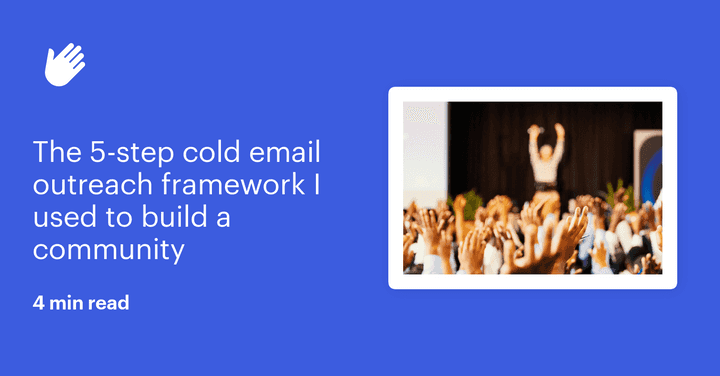The 5-step cold email outreach framework I used to build a community

In 2019, I had no network in Silicon Valley.
I spent the next 2 years building a community remotely through cold outreach.
While my framework is by no means exhaustive, the cold email secrets I’ll share can help you sell, fundraise, find a job – and navigate any field that involves relationships.
Here's the 5-step cold outreach framework I used to build a community of world-leading investors, founders, journalists, and operators.
Start with positivity
Most people wondering how to start a cold email ask themselves, "what value can I bring to the table?"
I want you to start by adding positivity. In practice, this means using specific compliments and clearly defining what about the person made you reach out to them.
Why do you admire them? Did their blog post you read ages ago inspire you? Did you see them on TV? Did your mom mention them?
By leading with positivity, you can expect these results to follow:
- The recipient will be more open to what follows
- You will build strong relationships
- You will bring more positivity into your life
Introduce your whole self
After you've shared a positive note, the recipient of your email will wonder, who is this person?
Be authentic when you answer. Instead of listing your resume, I encourage you to share a quick summary of your current job, values, and interests. Why?
Chances are they'll find something in common. If the person who opens your emails sees themselves in your introduction, they are more likely to respond.
Ask a thoughtful question
After you've successfully accomplished steps 1 and 2, it's time for your call to action.
I used to make the mistake of asking for "just 10 minutes of your time on a call." This is a lot to ask on initial outreach. In reality, “just 10 minutes” requires more than that amount of time just to schedule the call, blocks out other opportunities, and can zap energy if it’s the person’s 10th call of the day.
Instead, ask a thoughtful question.
The busier I got, the more I loved answering questions via email. I could come back to them when I had time, answer them thoughtfully, reuse them in blog posts, and scale my time better. Ask the one question that will motivate the person to respond thoughtfully.
You might be asking yourself, “but, have you found a good way to transition from one question to something deeper, like a call?”
I would encourage you to reflect on whether or not a call is actually necessary. What are you hoping to get out of a call with them? When they reply to your initial email, follow up with the questions that will get you closer to the insight you’re seeking. Honestly, some of my favorite exchanges have been email threads that have spanned years that I'd come back to every so often.
Prove you did your homework
You might think you’re done at this point, but not so fast!
Most people would think they're done here, but you'd be overlooking an undervalued piece of email real estate – the ps. It's less formal, and you can show them you really did your homework by mentioning an interest of theirs that you share.
Don’t forget to follow up
If you don’t get an immediate response, don’t get down on yourself.
The person you emailed likely has an overflowing inbox and other critical priorities. Sometimes, they may have even seen your email and intended to respond, but got distracted by something else.
Follow up with them in two weeks so they don’t forget your email completely. And don’t just say, “did you see my last email?” To increase your chances of a thoughtful response (and reduce the sting of no response), I recommend the following:
- Send a relevant article or timely congrats message to make the follow-up seem naturally timed, not on a two-week timer
- Send out messages in batches so you aren’t attached to any one response
Raise the bar
This framework works so well because the bar for cold email outreach is low. Honestly, a lot of emails suck. Don't fall into the trap of doing what everyone usually does. Be positive. Be authentic. Be thoughtful. And follow up!
For more tactical advice on building a network, breaking into tech, and leading a happy, healthy, and productive life, subscribe to my youtube here.
This post is an adapted and expanded version of my Tweet thread.
Build a stronger network
Many community-building experts, like Paige, are surprisingly open about how they've built their communities. Check out our building in public inspiration post for actionable lessons on communication and networking directly from the pros.

Paige Finn Doherty
Founding partner at Behind Genius Ventures and the host of Seed to Harvest, a weekly podcast on stories & tactics from a diverse array of investors, founders, and creators.